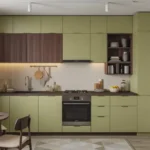Look, I’ll be honest—when I first heard “green countertops,” my brain immediately went to that avocado-green laminate from the ’70s that screamed “grandma’s kitchen.” But boy, was I wrong. Green countertops have had a serious glow-up, and they’re absolutely crushing it in the kitchen design world right now.
Whether you’re into earthy vibes, modern aesthetics, or just want something that doesn’t look like every other gray-and-white kitchen on Pinterest, green counters might be your answer.
I’ve spent way too many late nights scrolling through kitchen inspiration (my partner thinks I have a problem), and I’ve noticed green countertops popping up everywhere.
From soft, whisper-quiet mints to deep, moody forest greens that make you feel like you’re cooking in an enchanted woodland—there’s a shade for everyone.
So grab your coffee, get comfy, and let’s talk about 15 green countertop ideas that’ll make you want to renovate your kitchen tomorrow.
Modern Sage Green Countertop Kitchen Designs
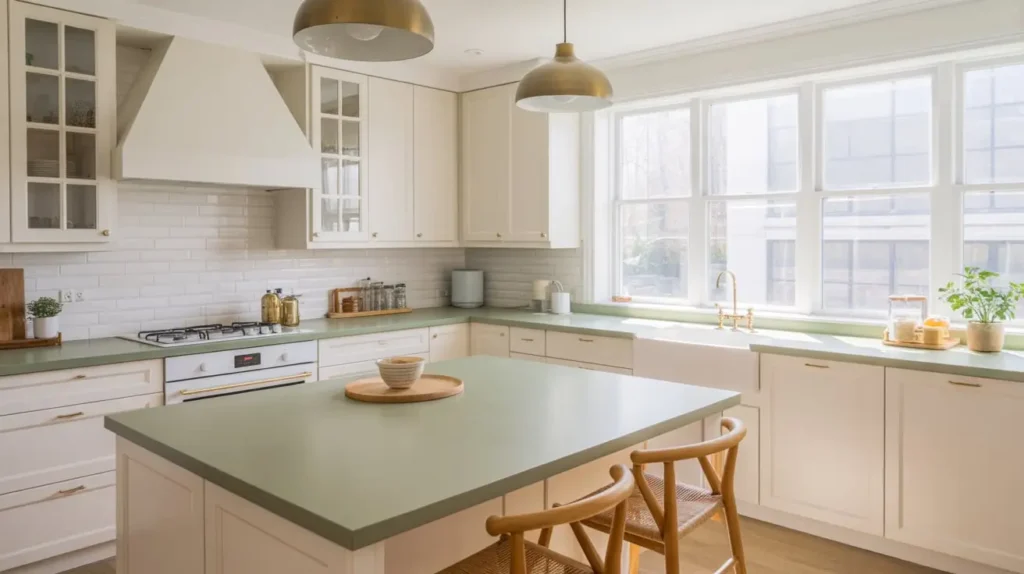
Sage green is having a moment, and honestly? I’m here for it. This muted, sophisticated green brings a calming, organic feel to modern kitchens without screaming for attention like some colors do (looking at you, millennial pink).
Modern sage green countertops work beautifully because they bridge the gap between neutral and colorful. You get the visual interest of a colored surface, but it’s subtle enough that you won’t get tired of it in three years. I’ve seen these paired with white shaker cabinets and black hardware, and the combination is chef’s kiss.
What makes sage particularly versatile? It plays well with warm wood tones, cool grays, and even brass fixtures. You can go full minimalist or add more decorative elements—sage doesn’t judge. For a truly modern look, consider pairing sage green quartz countertops with handleless cabinets, concrete-look flooring, and matte black appliances. The result feels fresh but timeless, which is basically the holy grail of kitchen design.
Pro tip: If you’re worried about commitment (commitment-phobic much?), sage green works as either a statement piece or a supporting character in your kitchen’s story. You control the narrative.
Forest Green Marble Countertop Inspiration
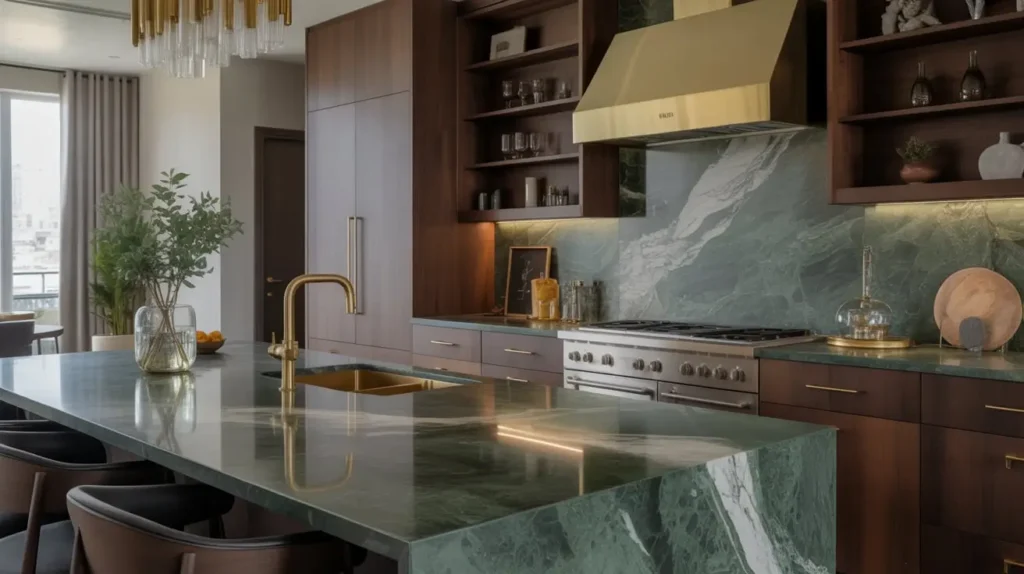
Ever walked into a kitchen and felt like you just entered a luxury hotel? That’s what forest green marble can do. This deep, rich green with dramatic veining creates an instant wow factor that makes your kitchen feel expensive—even if your budget was more “IKEA” than “interior designer.”
Forest green marble isn’t for the faint of heart. It’s bold, it’s unapologetic, and it absolutely demands attention. I’ve seen it work gorgeously in kitchens with gold or brass accents, dark wood cabinetry, and even all-white cabinets when you want the countertop to be the star of the show.
The veining in marble tells a story—no two slabs look identical. Some forest green marbles have white veining that creates movement across the surface, while others feature gold or cream streaks that add warmth. My personal favorite? The ones with subtle gold veining that catch the light at different times of day. It’s like your kitchen is performing a little light show just for you.
Fair warning though: marble requires maintenance. It needs sealing, it can stain if you spill your morning OJ and don’t wipe it up immediately, and it’s more delicate than engineered options. But IMO, the beauty is worth the extra TLC. Think of it as a high-maintenance friend who looks absolutely stunning—sometimes they’re worth the effort 🙂
Elegant Green and Gold Kitchen Aesthetic

Want to feel like royalty while making your morning toast? The green and gold combo delivers serious elegance without feeling stuffy or overdone. This pairing screams luxury but in a modern, accessible way.
When you combine green countertops with gold hardware, light fixtures, and faucet finishes, you create visual warmth that feels both sophisticated and inviting. I’ve noticed this trend particularly in kitchens that blend contemporary and traditional elements—think Shaker-style cabinets in soft cream or white with a green countertop and those gorgeous gold pulls that cost more than they should but look amazing.
The key to nailing this aesthetic? Balance. You don’t want to go full King Midas and gold-plate everything (unless that’s your vibe, then go for it). Instead, use gold as an accent that complements the green. Consider:
- Brass cabinet hardware in a brushed or satin finish
- Gold-framed pendant lights above an island
- Warm gold faucets that tie the look together
- Gold-rimmed bar stools for seating areas
The green you choose matters too. Emerald and jade greens look stunning with gold, creating a jewel-tone effect. Softer greens like celadon or mint create a more subtle, refined elegance when paired with brushed brass.
Also Read: 15 Luxurious Emerald Green Kitchen Ideas for 2025
Budget-Friendly Green Countertop Makeovers
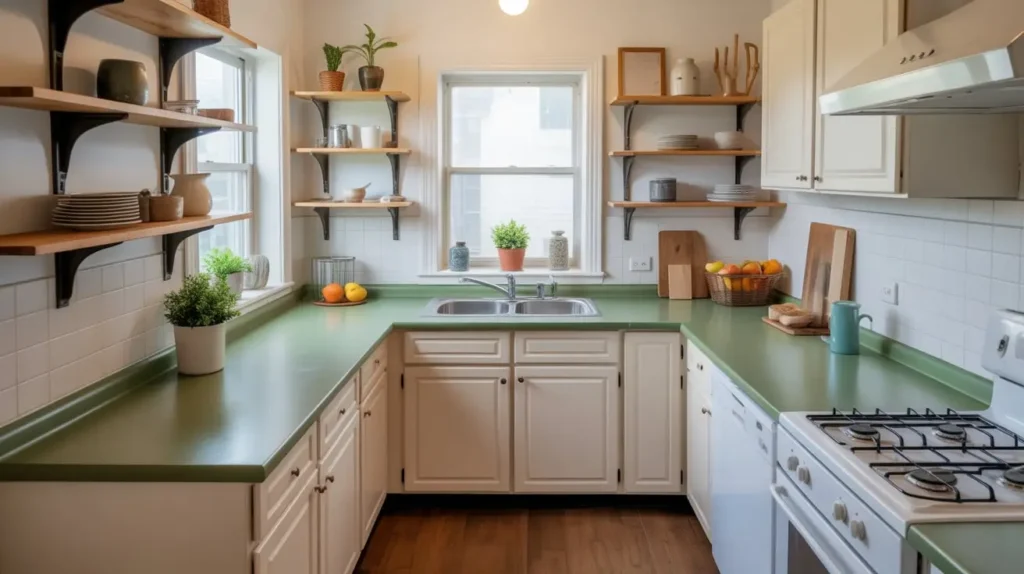
Let’s get real—not everyone has five figures to drop on new countertops. I certainly don’t. But that doesn’t mean you can’t have the green kitchen of your dreams. Budget-friendly options exist, and some of them look pretty darn good.
Laminate countertops have come a long way from the cheap-looking options of the past. Modern laminates can mimic stone, concrete, and yes, even green marble or quartz. You can find beautiful green laminate options that cost a fraction of natural stone prices. They’re durable, easy to install (or have installed), and if you get tired of them in a few years, replacing them won’t break the bank.
Another budget-friendly route? Tile. Green ceramic or porcelain tiles can create a unique, custom look. You can even mix different shades of green for a more complex, interesting surface. The grout lines aren’t for everyone, but they add character and make cleaning a bit more interesting (okay, maybe not more interesting, but you can pretend).
Here’s what I’ve learned about budget makeovers:
- Shop remnant yards at stone suppliers—you might find the perfect piece for less
- Consider DIY concrete overlays that you can tint green
- Look at contact paper as a temporary solution while you save for the real deal
- Check architectural salvage for reclaimed materials
You don’t need to spend like an HGTV show budget to get a kitchen you love. Sometimes creativity beats cash every time.
Best Cabinet Colors for Green Countertops

Choosing cabinet colors for green countertops stressed me out initially. What works? What clashes? What makes your kitchen look like a Christmas explosion gone wrong?
After obsessing over this question (and approximately 473 Pinterest boards), I’ve learned that green countertops are actually super versatile. They play well with more cabinet colors than you’d think.
White cabinets are the safe, classic choice. They let your green counters shine without competing for attention. You literally can’t go wrong with white—it’s the little black dress of kitchen cabinets. Crisp white with a deep green counter creates clean, fresh contrast that works in virtually any kitchen style.
Natural wood cabinets bring warmth and create an organic, earthy vibe. Light oak, walnut, or even bamboo cabinetry with green counters feels like bringing the outside in. This combination works beautifully in farmhouse, Scandinavian, and mid-century modern kitchens.
Dark cabinets might surprise you, but they can be stunning. Navy blue cabinets with sage green counters? Gorgeous. Black cabinets with emerald green counters? Dramatic and sophisticated. The key is ensuring you have enough light in the kitchen so it doesn’t feel like a cave.
Gray cabinets offer a modern, neutral backdrop. Warm grays work better than cool grays with most green tones—they feel harmonious rather than cold. And here’s a bold move: green cabinets with green counters in different shades creates a monochromatic look that’s unexpectedly chic.
Farmhouse Kitchen with Olive Green Counters

Farmhouse kitchens have been everywhere for years now, but adding olive green counters gives the style a fresh twist. Olive green feels earthy and grounded—perfect for that cozy, lived-in farmhouse aesthetic.
I absolutely love how olive green counters look with reclaimed wood, apron-front sinks, and open shelving displaying vintage dishware. The color feels rustic without being too country (you know, that fine line between charming farmhouse and rooster-themed nightmare).
For a farmhouse kitchen with olive green counters, consider these elements:
- Butcher block island paired with olive green perimeter counters
- White subway tile backsplash for classic appeal
- Matte black fixtures and hardware
- Open shelving with wood brackets
- Vintage-inspired lighting like schoolhouse pendants
The beauty of olive green in farmhouse spaces? It works with both warm and cool tones, so you have flexibility in your overall color scheme. You can lean into warm creams and beiges or cool it down with whites and grays.
What really sells this look is layering textures. Smooth olive counters, rough wood beams, soft linen curtains, and metal accents create visual interest that keeps the space from feeling flat or boring. Farmhouse done right feels collected over time, not bought all at once from the same store (even if it was).
Minimalist Kitchens with Soft Mint Countertops
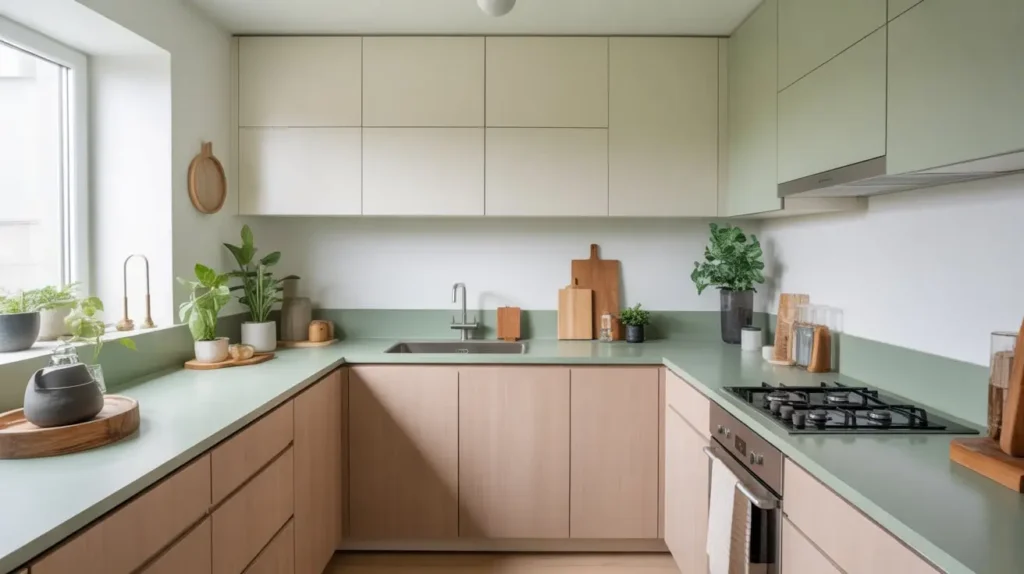
Minimalism doesn’t mean boring, and soft mint countertops prove it. This barely-there green adds just enough color to create interest while maintaining that clean, uncluttered aesthetic minimalists crave.
Soft mint works beautifully in minimalist spaces because it’s calming and subtle. It doesn’t demand attention or create visual noise. I’ve seen these paired with all-white cabinets, stainless steel appliances, and minimal hardware, and the effect is serene without being cold.
The trick with minimalist design is intentionality. Every element needs a purpose. Your soft mint countertop becomes a quiet focal point—noticeable but not overwhelming. FYI, this shade works particularly well in smaller kitchens because it doesn’t visually shrink the space like darker colors can.
For a truly minimalist approach with mint counters:
- Keep your color palette to 2-3 colors maximum
- Choose handleless cabinets for clean lines
- Use hidden storage to maintain clutter-free surfaces
- Incorporate natural light as a design element
- Select simple, geometric lighting fixtures
Soft mint also has this magical quality where it can read as almost neutral in certain lighting but shows its personality when the light changes. It’s like the quiet person at the party who turns out to be the most interesting when you actually talk to them.
Dark Green Quartz Countertop Styling Ideas

Dark green quartz countertops are for people who want to make a statement. This isn’t subtle. This isn’t background. This is bold, dramatic, and absolutely gorgeous when styled correctly.
I’m slightly obsessed with dark green quartz because it offers all the drama of natural stone without the maintenance headaches. You get that deep, rich color—sometimes with veining that mimics marble—but in a non-porous, stain-resistant surface that can handle whatever your kitchen throws at it.
Styling dark green quartz requires some thought. Too many dark elements and your kitchen feels like a dungeon. Too light and the contrast might be jarring. The sweet spot? Balanced contrast with thoughtful layering.
Here’s what works:
- Light or medium-toned cabinets to prevent the space from feeling too dark
- Metallic accents in brass, copper, or gold to add warmth
- Under-cabinet lighting to illuminate the workspace and highlight the counter
- Large windows or additional lighting to balance the dark surface
- Light-colored backsplash to break up the darkness
I’ve seen dark green quartz work beautifully in both modern and traditional kitchens. In modern spaces, pair it with sleek white cabinets and minimalist hardware. In traditional kitchens, combine it with detailed cabinetry and classic fixtures.
One styling idea I love? Using dark green quartz on the island only, with a lighter counter on the perimeter. This creates a focal point without committing your entire kitchen to the dark side.
Also Read: 15 Aesthetic Pink and Green Kitchen Ideas You’ll Adore
White Kitchens with Green Countertop Accents
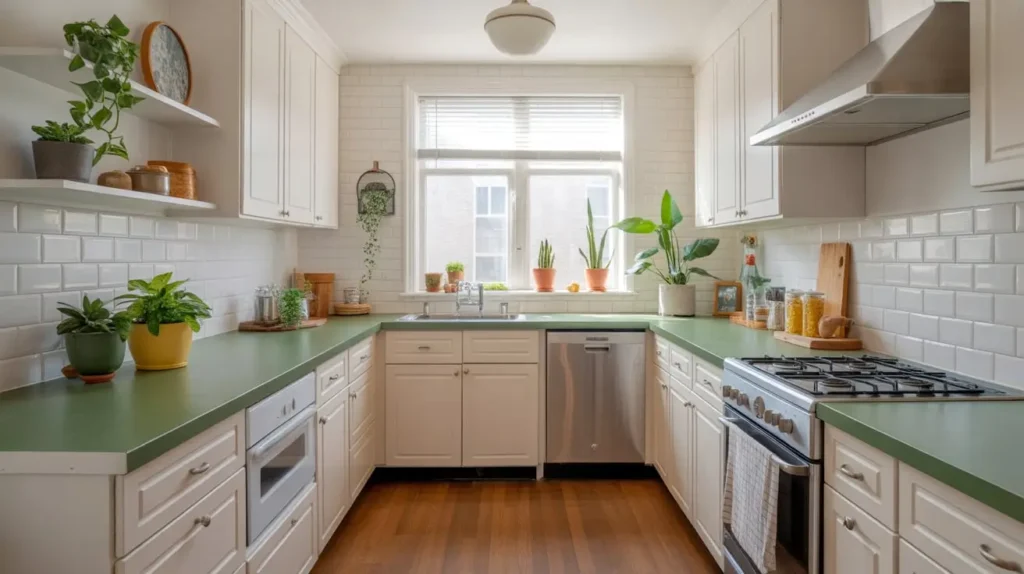
White kitchens are everywhere, and look—I get it. They’re clean, bright, and easy to sell if you move. But they can also be a bit… boring? That’s where green countertop accents come in clutch.
Adding green counters to an otherwise white kitchen is like adding the perfect accessory to an all-white outfit. It completes the look and gives it personality. You maintain all the brightness and spaciousness of a white kitchen but add visual interest that prevents it from feeling sterile or bland.
The beauty of this approach is versatility. You can go subtle with a soft sage or mint, or bold with emerald or forest green. The white backdrop supports whatever shade you choose. I particularly love seeing white perimeter cabinets with a green island countertop—it creates a focal point that naturally draws people into the space.
Consider these combinations:
- White shaker cabinets with sage green quartz counters
- Glossy white cabinets with dark green marble for contrast
- White beadboard cabinetry with mint laminate for cottage charm
- Modern white cabinets with hunter green quartz for drama
The green doesn’t just add color—it adds depth and dimension that all-white kitchens sometimes lack. It’s like your kitchen took a personality test and discovered it’s actually interesting (sorry, all-white kitchens, I still love you too).
Eco-Friendly Green Countertop Materials
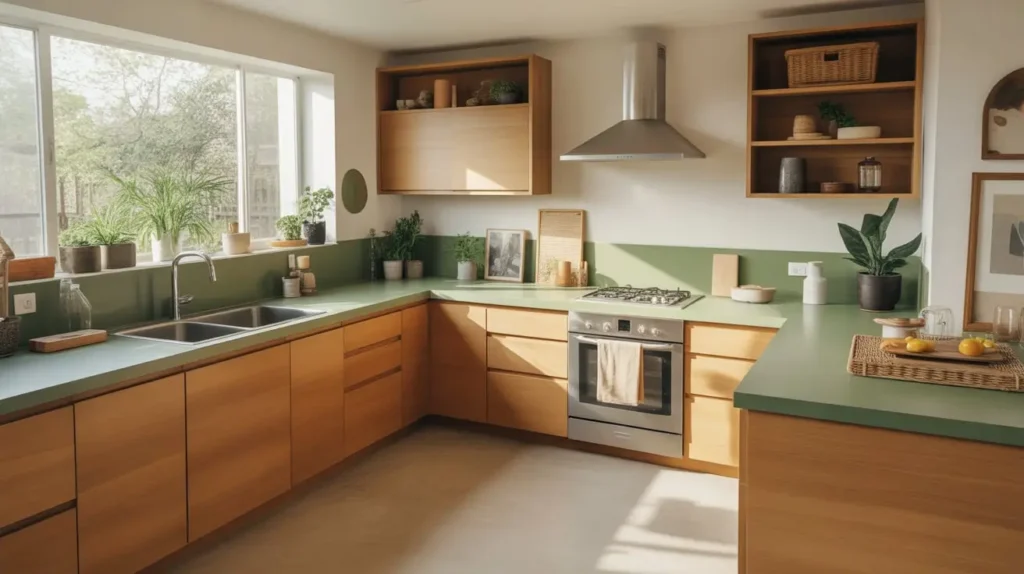
Want your green countertops to be actually green? Like, environmentally green? Same. The good news is that several sustainable countertop options come in gorgeous green shades.
Recycled glass countertops are probably the most obviously eco-friendly option. Manufacturers take post-consumer glass and bind it with resin or cement to create colorful, unique surfaces. You can find options with green glass pieces that create a terrazzo-like effect. Each slab is unique, the material diverts waste from landfills, and they’re durable enough for everyday use.
Paper composite countertops might sound weird, but hear me out. Companies take recycled paper, saturate it with resin, and compress it into solid surfaces. You can find these in various green shades, and they’re surprisingly durable and heat-resistant. Plus, they feel warm to the touch—not cold like stone—which is nice when you’re leaning against the counter with your morning coffee.
Other eco-friendly options worth considering:
- Reclaimed or salvaged stone in green tones
- Bio-glass made from recycled materials
- Locally sourced stone to reduce transportation emissions
- Concrete with green pigments (can include recycled content)
The greenest option might actually be keeping your existing counters and refinishing them. You can resurface or paint them green, which uses fewer resources than manufacturing new materials. Not as glamorous, maybe, but your carbon footprint will thank you.
Going eco-friendly doesn’t mean sacrificing style. Many sustainable materials look just as good (sometimes better) than conventional options, and you get the added bonus of feeling smug about your environmental choices (kidding… kind of).
Small Kitchen Makeovers Using Green Counters
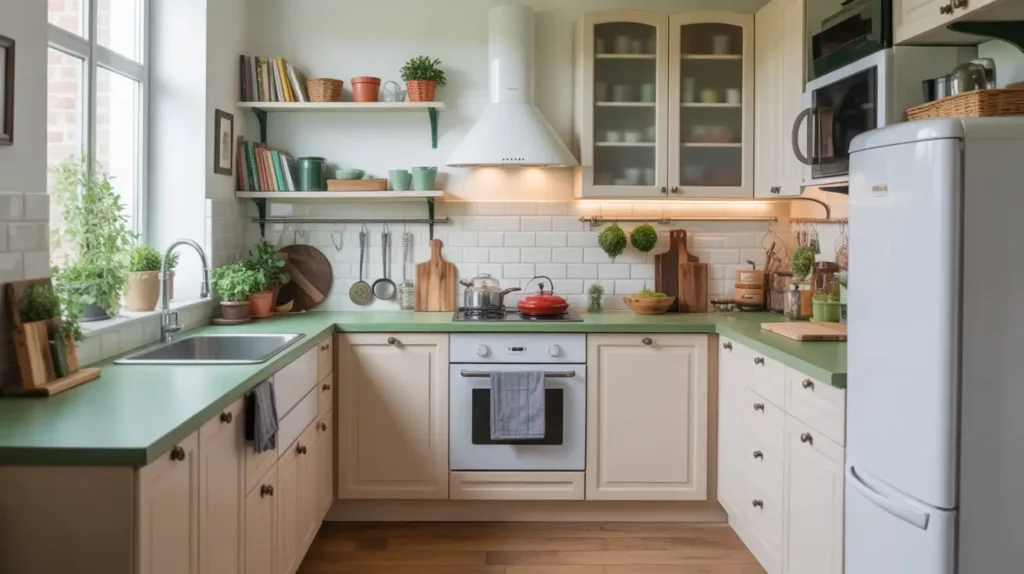
Small kitchens present unique challenges, but green countertops can actually work in your favor. The key is choosing the right shade and designing around it intentionally.
Lighter greens—think mint, celadon, or soft sage—can make small spaces feel larger and brighter. These shades reflect light rather than absorbing it, which helps create an airy feeling even in a compact kitchen. I’ve seen tiny galley kitchens transformed by swapping dark counters for light green ones, and the difference is remarkable.
That said, if you want to go darker, you absolutely can. Deep green counters in a small kitchen create a cozy, jewel-box effect. Embrace the coziness rather than fighting against it. Add good lighting, some reflective surfaces, and you’ve got an intimate space that feels intentional rather than cramped.
Smart strategies for small kitchens with green counters:
- Use the same green on all counters for visual continuity
- Pair with light-colored cabinets to maintain brightness
- Install adequate lighting, including under-cabinet lights
- Choose minimal patterns in backsplash and flooring
- Incorporate mirrors or reflective surfaces to bounce light
One trick I love for small kitchens? Using a waterfall edge on your green countertop if you have a small island or peninsula. It draws the eye vertically and makes the space feel taller, plus it just looks really cool.
Small kitchens force you to be creative and intentional with every choice. A green countertop can be that unique element that makes your small kitchen memorable rather than forgettable.
Boho-Inspired Green Kitchen Color Combos

Boho style is all about mixing patterns, textures, and colors in a way that feels effortlessly eclectic. Green countertops fit perfectly into this aesthetic, especially when you play with unexpected color combinations.
For boho kitchens, I love pairing green counters with terracotta, warm oranges, dusty pinks, and rich blues. These colors create a warm, collected-over-time vibe that’s quintessentially bohemian. Your green counter becomes one element in a larger, colorful story.
Texture is huge in boho spaces. Smooth green counters contrast beautifully with:
- Rough, textured backsplash tiles in Moroccan or geometric patterns
- Natural fiber rugs in jute or sisal
- Rattan or woven bar stools
- Macramé plant hangers (because are you even boho without plants?)
- Open shelving displaying colorful dishware and pottery
The boho approach to green counters is fearless. You’re not worried about everything matching perfectly—you’re creating a space that feels personal and collected. Mix your metals (brass, copper, iron), combine patterns (florals, geometrics, stripes), and layer in plenty of greenery to complement your green counters.
One of my favorite boho color combos? Sage green counters with rust-colored cabinets, cream walls, and blue vintage tiles as a backsplash. It sounds chaotic on paper, but in practice, it’s stunning. The green ties all these warm tones together and keeps the space feeling grounded.
Green Countertop Backsplash Pairing Guide

Choosing a backsplash for green countertops stumped me initially. What complements without clashing? What adds interest without creating visual chaos? Let me save you some decision fatigue.
White subway tile is the safe, classic choice that literally always works. It’s like the white t-shirt of backsplashes—it goes with everything and never looks wrong. With green counters, white subway tile creates clean contrast that highlights the counter color. You can keep it simple with standard installation or add interest with herringbone or vertical patterns.
Natural stone backsplash in neutral tones (cream, beige, light gray) creates an organic, cohesive look. If your green counter has veining or movement, a subtle stone backsplash lets that detail shine without competing.
Want more personality? Consider these options:
- Patterned cement tiles in complementary colors
- Glass tiles that reflect light and add shimmer
- Metallic tiles in brass or copper for warmth
- Wood planks for a rustic, unexpected twist
- Solid color tiles in cream, white, or even a contrasting green shade
Here’s something I learned the hard way: if your green counter is busy (lots of veining, variation, pattern), keep your backsplash simple. If your counter is solid and uniform, you have more freedom to go bold with the backsplash.
Color temperature matters too. Cool-toned greens (those leaning blue) pair well with grays and whites. Warm-toned greens (those leaning yellow or brown) look better with creams, beiges, and warm grays. Matching temperature prevents that “something’s off but I can’t figure out what” feeling.
Vintage Kitchens Featuring Emerald Counters
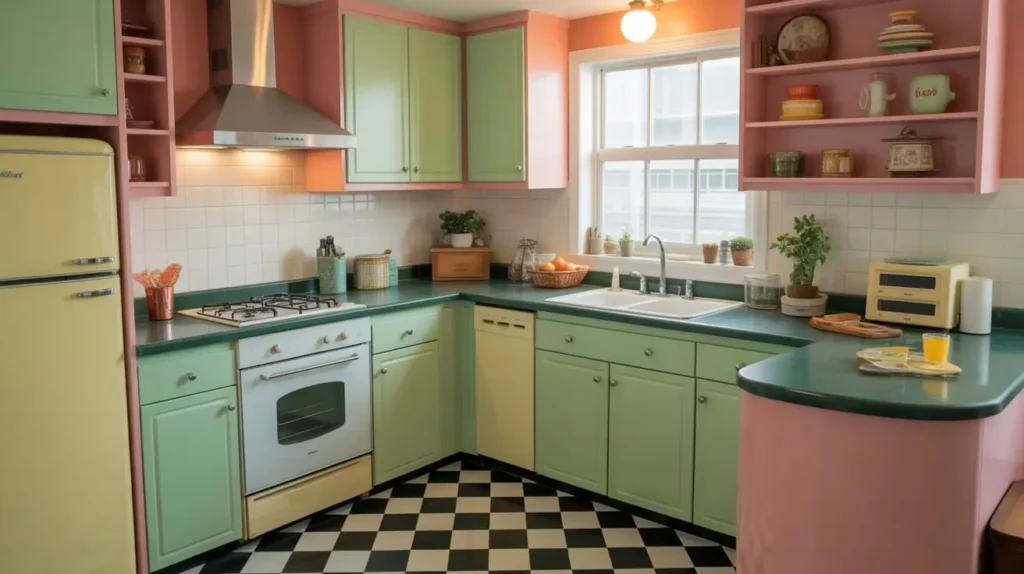
Vintage kitchens have serious charm, and emerald green counters can enhance that retro appeal while still feeling fresh. Emerald is rich, jewel-toned, and undeniably glamorous—perfect for creating that vintage-meets-modern aesthetic.
I’ve seen emerald counters work beautifully in kitchens channeling different eras. For a 1950s vibe, pair emerald with chrome fixtures, retro appliances, and black-and-white checkered flooring. The combination feels authentically mid-century without being costume-y.
For 1970s-inspired spaces (yes, they’re back and cooler than ever), emerald counters work with warm wood cabinets, mustard yellow accents, and geometric patterns. It’s groovy without being over-the-top.
Key elements for vintage kitchens with emerald counters:
- Vintage-style fixtures like bridge faucets or retro pulls
- Period-appropriate lighting such as globe pendants or cone shades
- Vintage appliances (or modern ones designed to look vintage)
- Classic color combinations that nod to the era you’re channeling
- Detailed cabinetry with inset doors or decorative elements
The emerald shade itself reads vintage because it was popular in various eras, from Art Deco to mid-century modern. It has history and nostalgia built into its DNA, which makes it perfect for vintage-inspired spaces.
What I love about this approach is how it honors the past without feeling dated. You’re creating something that feels collected and curated, not stuck in time. Your emerald counters become a bridge between then and now.
DIY Painted Green Countertop Transformations
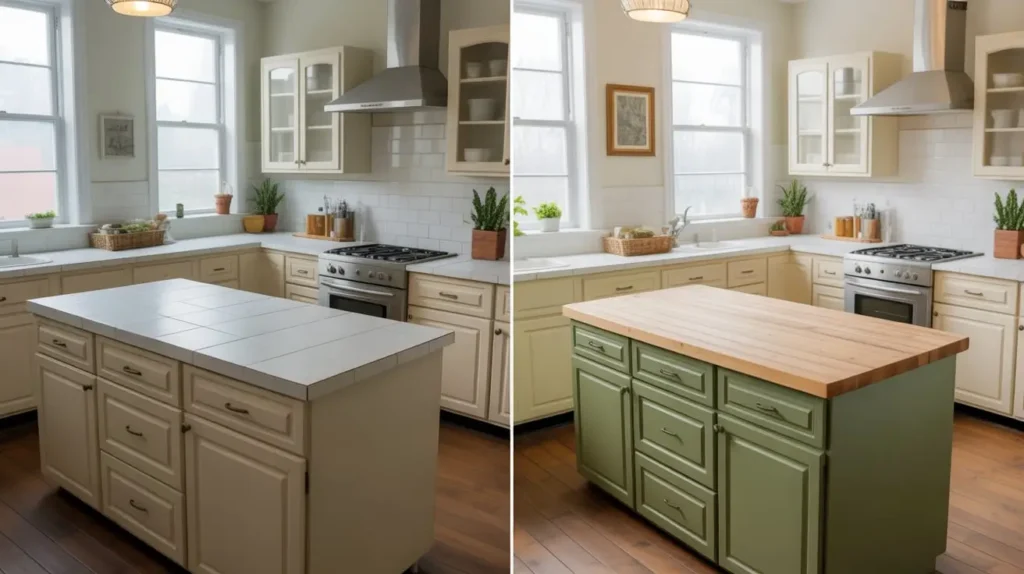
Look, I know painted countertops aren’t for everyone. Some people think they’re a temporary Band-Aid solution, and honestly? They kind of are. But if you’re working with a tight budget or renting, DIY painted countertops can transform your kitchen for under $100.
I’ll be straight with you—painted counters require prep work, the right products, and realistic expectations. They won’t last forever. They’re not as durable as stone or quartz. But they can look surprisingly good and buy you time until you can afford the real deal.
The process involves thoroughly cleaning and sanding your existing counters, applying primer, painting with specialty countertop paint or a combination of paint and additives, and sealing with multiple coats of protective topcoat. You can create solid color green counters or get fancy with sponging, marbling, or other faux-finish techniques.
For green painted counters, consider:
- Chalk paint in custom-mixed green shades
- Mineral-based paints that adhere well to multiple surfaces
- Specialty countertop kits that include everything you need
- Epoxy mixed with green pigment for a glass-like finish
The pros? It’s cheap, DIY-friendly, and temporary (which is also kind of a con). You can change it whenever you want. The cons? It requires maintenance, can chip or scratch, and needs reapplication over time.
My advice if you go this route: Follow instructions exactly, don’t skip steps (especially sealing), and be gentle with your new surface while it fully cures. Also, maybe don’t mention to dinner guests that you painted your counters unless they specifically ask—it’s your little secret 🙂
The Bottom Line
Green countertops aren’t just having a moment—they’re having a whole movement. From soft, subtle mints to dramatic emeralds and everything in between, there’s a green for every style, budget, and kitchen size. Whether you’re renovating your forever home or just want to refresh your space without the commitment of a full remodel, green counters offer versatility and personality that neutral surfaces sometimes lack.
What I love most about this trend is how it brings nature into one of our most-used spaces. Kitchens should feel alive, warm, and inviting—and green, in all its variations, delivers exactly that. It’s earthy without being crunchy, colorful without being overwhelming, and distinctive without being trendy in that “this will look dated in two years” kind of way.
So whether you’re going all-in with forest green marble, dipping your toe in with painted laminate, or somewhere in between with sage quartz, you’re joining a design movement that celebrates color, creativity, and the courage to try something different than the standard gray-and-white kitchen that’s been everywhere for the past decade.
Your kitchen should make you happy every time you walk into it. If that happiness comes in shades of green, I say go for it. Pin your favorites, gather your inspiration, and start planning that green countertop kitchen you’ve been daydreaming about. Trust me, future you will thank present you for being bold enough to choose something you actually love.




